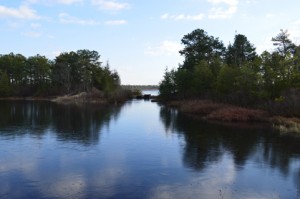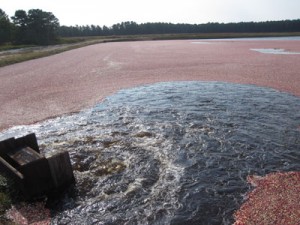This week, it was once again time for the annual New Jersey Audubon Corporate Stewardship Council meeting. The Corporate Stewardship Council is a unique group of New Jersey companies united behind a common goal of environmental sustainability and responsibility in NJ and meets as a group annually with the NJ Audubon and representatives of the NJ DEP and the US Fish and Wildlife Service. This year’s meeting was held Thursday in Trenton, and while CEO Bill Haines was unable to attend, he sent his daughter Stefanie Haines as his representative. Most of the meeting consisted of summaries and updates of projects from the past year and an introduction to new projects. Of particular interest to Pine Island was speaker Andrew Johnson, director of the Watershed Protection Program, William Penn Foundation.
Good water management is not only the crucial part of our work here at Pine Island – it’s essential to the balance of agriculture production with the Pinelands environment. To that end, we have over the course of many years carefully crafted a system that works with both nature and gravity to best maintain and preserve the bounty of natural resources available to us. This makes the work that the William Penn Foundation does with the Delaware River Watershed Initiative particularly important to us, as one of the areas they have targeted as a subwatershed “cluster” is the Kirkwood-Cohansey aquifer, which provides so much of the water that our cranberries need.
One of the initiative’s goals include:
Permanently protecting more than 30,000 acres of forested headwaters in critical areas. . .These efforts will preserve essential habitats and mitigate climate change as well as sustain water quality in the more intact sub-watersheds.
One of Pine Island Cranberry’s core values has always been protecting the environment: caring for the place where we live, work, and grow. To that end, we have been working since 2001 with forester Bob Williams of Pine Creek Forestry to create and implement a forest stewardship plan. Creating a specific plan helps us protect and improve forest resources by doing practices such as prescribed burning, thinning, and replanting with improved trees. We are improving the forest habitat while at the same time conducting all the necessary work to have a thriving, profitable cranberry operation and protecting our water supply.
NJ Audubon Stewardship Project Director John Parke then gave the attendees an overview of several projects that council members have worked on over the past year. His genuine enthusiasm and joy with what he does, as always, made his energy contagious, and it was great to hear about some of the other ongoing projects that are happening statewide! It was especially exciting to hear about the work Atlantic City Electric is doing for the bobwhite quail:
[Their] project proposal aims to increase resources for for northern bobwhite quail (Colinus virginianus)by creating and managing early successional habitat. Proposed restoration activities include planting native grasses and forbs to improve foraging habitat, retaining native shrubs for winter cover, and creating small canopy openings along the transmission lines to expand habitat.
It was wonderful to have some time to chat with people who share our commitment to resource conservation and are equally committed to putting in the hard work to make it happen, and we are grateful to New Jersey Audubon for giving us the opportunity!



